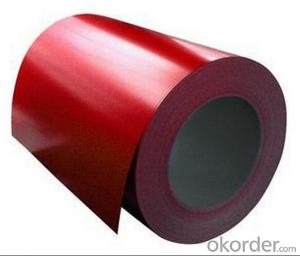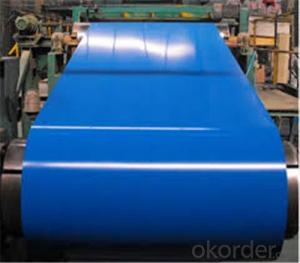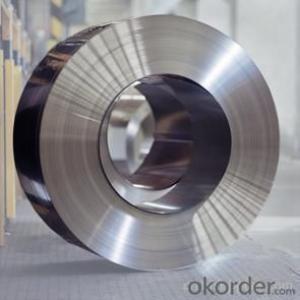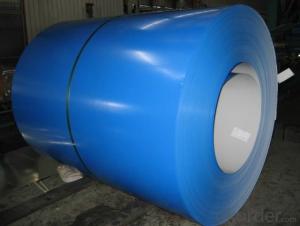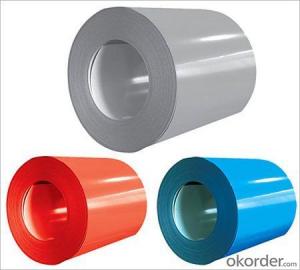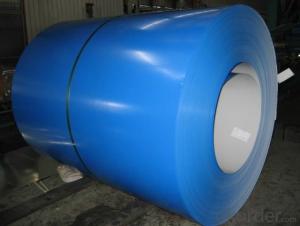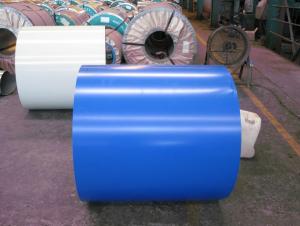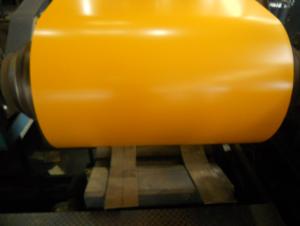Pre-painted Aluzinc Steel Coils with CE Certificate
- Loading Port:
- Tianjin
- Payment Terms:
- TT OR LC
- Min Order Qty:
- 10 m.t.
- Supply Capability:
- 1000 m.t./month
OKorder Service Pledge
OKorder Financial Service
You Might Also Like
Specification
1.Brief Introduction of Pre-painted Aluzinc Steel Coils:
PPGI steel Coil is made by cold rolled steel sheet, then through chromated, unoiled, various spangles, hot dipped. The surface is coated by aluzinc. And it is of hight strength, strong firmness, good rain resistance, consistent rolling, good corrosion resistance, low time cost, and it is easy and convenient to install and dismantle.
2.Applications
construction | workshop, agricultural warehouse, residential precast unit, corrugated wall, rainwater drainage pipe, terrace, retailer booth, roller shutter door |
door, doorcase, light steel roof structure, folding screen, ceiling,elevator, stairway, vent gutter | |
Electrical appliance | refrigerator, washer, switch cabinet, instrument cabinet, air conditioning, micro-wave oven, bread maker |
Furniture | central heating slice, lampshade, chifforobe, desk, bed, locker, bookshelf |
Carrying trade | exterior decoration of auto and train, clapboard, container, isolation lairage, isolation board |
3.Prepainted Galvanized Steel Images:
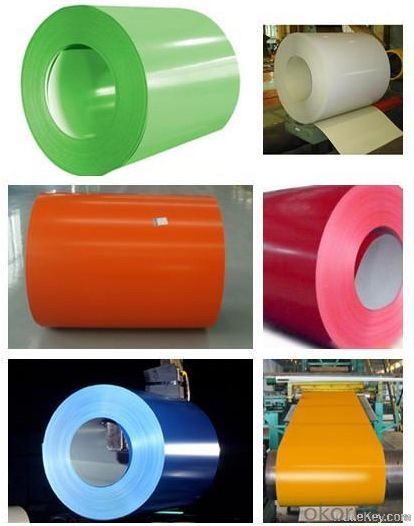
4.Galvanized Steel Specification:
| 1)Length: | as requirement |
| (2)Width: | 914mm, 1000mm, 1200mm, 1220mm, 1250mm or other width |
| (3)Thickness: | 0.20-1.20mm |
| (4)Zinc Coating: | 40-750g/m2 |
| (5)Single Weight: | 3-8MT |
| (6)Coil id: | 508mm or 610mm |
| (7)Top Coating: | 11-25um(+5-7) |
| (8)Back Coating: | 5-7um |
| (9)Paint: | EXPOXY, POLYESTER, PVDF |
| (10)Color: | RAL or customer's sample (common:sea blue, white grey and bright red) |
| (11)Grade: | SGCD,SGCH, Q195,DX51D |
| (12)Standard: | ASTM A653M-04/JIS G3302/DIN EN10143/GBT 2518-2008 |
| (13)Substrate: | Hot dip galvanized steel (HDGI), Zincalume steel coil |
| (14)Surface Protection: | PE, PVDF, HDP,SMP ect. |
| (15)Surface Treatment: | Galvanized, Chromated , Bright Finished, Spangle, Fingerprint Resistance. |
| (16)Proformance: | Smooth or Matte or anti-scratch |
5.Our Factory:

6.FAQ
We have organized several common questions for our clients,may help you sincerely:
①How about your Warranty?
Warranty: 1-Year for the whole light. Warranty is based on correct storage, installation, using and maintenanc
②How to guarantee the quality of the products?
We have established the international advanced quality management system,every link from raw material to final product we have strict quality test;We resolutely put an end to unqualified products flowing into the market. At the same time, we will provide necessary follow-up service assurance.
③How long can we receive the product after purchase?
In the purchase of product within three working days, We will arrange the factory delivery as soon as possible. The pecific time of receiving is related to the state and position of customers.Commonly 7 to 10 working days can be served.
- Q: What temp does fire have to be to melt steel?
- more than 300° F
- Q: How do steel coils contribute to the HVAC ductwork industry?
- Steel coils are an essential component in the HVAC ductwork industry as they are used to fabricate and shape the ducts. The coils are formed into various sizes and shapes, allowing for efficient air circulation and distribution within heating, ventilation, and air conditioning systems. These durable coils provide structural integrity to the ductwork, ensuring a reliable and long-lasting solution for HVAC installations.
- Q: I want to anodize steel using heat. some steel turns gray instead of coloring when I heat it up using a torch.
- Steel doesn't anodize in the sense that aluminum and some other metals do. However, it can be heat-colored. The trick is to clean the surface first (it must be oxide free), then heat gently until the colors appear. These are called temper colors in steel. They are due to a thin adherent layer of oxide that forms and thickens as temperature is increased. They are quite temperature dependent. As the steel is heated, the first color to appear is pale yellow. This will progress through darker yellows, browns, purples, and blues as the temperature rises. Above blue, the oxide becomes the gray/black color you are apparently getting - this is the result of heating too fast and too hot. See the chart at the site below for colors in plain carbon steel. Note that the temperatures are pretty low - It all starts around 400 F and if you go above 600 F the show's all over.
- Q: Can steel coils be returned if they are damaged?
- Yes, steel coils can be returned if they are damaged. Most suppliers and manufacturers have return policies in place for damaged goods, including steel coils. It is important to contact the supplier or manufacturer promptly and provide documentation or evidence of the damage to initiate the return process.
- Q: I'm getting microdermals, from a very experienced piercer, but they don't have titanium and I know titanium is the best for this, but is Grade A Srugical Steel okay too?(P.S. also instead of getting flat heads, of the microdermals, I'm getting flat crystal like ones, are those okay? I know to be careful, I am veryyyy careful with my body, so much that I'm worried I'm going to overly do it when I get them and dry out the skin or something hahaa xp)THANK YOU ALL IN ADVANCE FOR THE HELP
- Perfect! 3
- Q: Can steel coils be cut to length?
- Yes, steel coils can be cut to length.
- Q: What are the common applications of galvanized steel coils?
- Galvanized steel coils are commonly used in various applications such as construction, automotive manufacturing, electrical appliances, and infrastructure projects. They are used for manufacturing roofing sheets, wall panels, pipes, gutters, and various structural components due to their corrosion resistance and durability. Additionally, galvanized steel coils are widely used in the production of automotive parts, such as body panels, frames, and chassis, as they provide excellent strength and protection against rust.
- Q: What are the pros and cons of non-stick and stainless steel pots and pans ?Thanks
- NEVER cook eggs in anything other than a nonstick pan. They stick real good! Though nonstick surface does wear off eventually and you have to get new ones..
- Q: Why is the steel tape tape head not fixed?
- It makes sense to be irregular;You can see the standard ruler of steel roll head is a gap, when you take the time to object quantity, the head will indent the gap, so you measure is the size of the head from the head of steel;When you hook the object, the head will pull apart and you'll take the dimension from the end of the steel head.
- Q: How are steel coils used in the manufacturing of bridges?
- Steel coils are used in the manufacturing of bridges as they provide the raw material for creating structural components such as beams, girders, and columns. These coils are processed and shaped into the required sections, which are then assembled and welded together to form the bridge's framework. The strength and durability of steel make it an ideal material for constructing bridges that can withstand heavy loads and harsh environmental conditions.
Send your message to us
Pre-painted Aluzinc Steel Coils with CE Certificate
- Loading Port:
- Tianjin
- Payment Terms:
- TT OR LC
- Min Order Qty:
- 10 m.t.
- Supply Capability:
- 1000 m.t./month
OKorder Service Pledge
OKorder Financial Service
Similar products
Hot products
Hot Searches
Related keywords
